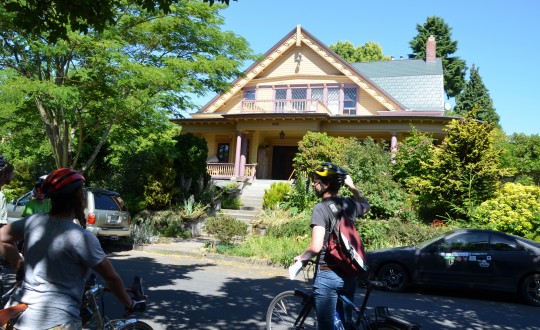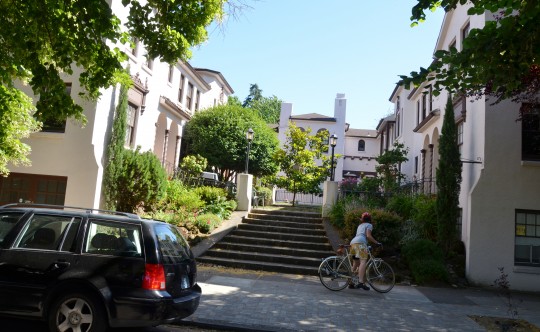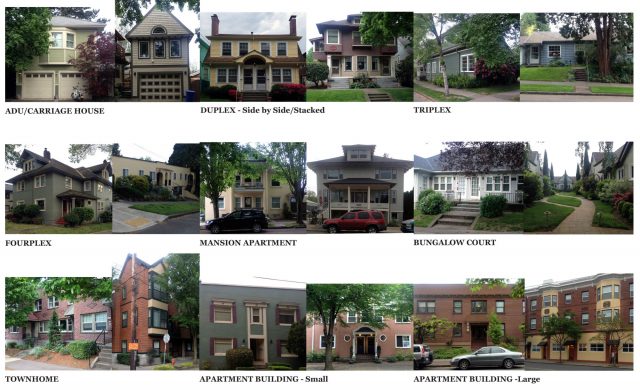This post is written by Neil Heller, a Portland-based planning consultant.
I recently visited a shop to get a new bike. I was shown two options: a gorgeous, yet expensive, custom-built single-speed cruiser and a massive cargo bike with all sorts of gleaming add-ons including an electric assist.
I like both of these bikes but they don’t quite fit my riding style — short commutes but also a bit of recreational road cycling on the weekends. I asked about a more versatile bike, one in between the two I was being shown, but was told road bikes are illegal.
Certainly I had seen some road bikes being ridden on my way over? These types are all an older style, I was informed, and can only be purchased used. No new road bikes are being built right now. Sorry.
By now it’s that you already see the metaphor and realize I never visited such a shop. I think this metaphor for housing choice is a good one because it highlights how laughable having such limited options can be.
Many of Portland’s most-loved neighborhoods are awash in beautiful single-family homes and wildlife-habitat-certified landscapes. Having leafy streets lined with front porches and landscaped yards so close to the Central City is a lovely pattern that defines Portland character, one not found in many other large cities on the West Coast. It is rare to find a city where one can find so many of these in such a setting a mere three miles from a downtown.
Post-recession, and in response to changing market preferences for denser urban living, another prominent type of housing being built in popular neighborhoods is the four-to-six-story mixed-use, mid-rise apartment building. Some of these have received criticisms of being “out of character,” or even worse, “soulless.” But much like the cargo bike, these types have a lot of capacity and go a long way to capture much of the population growth we are currently experiencing. For some of us, they’re the right answer.
In the current market we are mostly seeing these two products being built: single-family homes and the mid-rise apartment buildings found along our neighborhood corridors and centers. These options tend to cater to only one or two life phases. These products have their place, but what if you cannot afford the custom-built single speed and the high-capacity cargo bike doesn’t fit your lifestyle? What other options do you have?
The missing middle housing types: Already next door, but illegal to build
What if the available options covered a wide spectrum of housing choice with enough variety to meet a range of differing lifestyles and incomes? One term aptly describes these options as the ‘Missing Middle.’ The term is a straightforward description: the ‘Middle’ portion of the term represents the unit types found between single family and mid-rise apartments, where the ‘Missing’ describes the housing trends of recent history where these types of housing option have been largely ignored or prohibited by municipal regulations.
The following list describes the range of Missing Middle unit types that can be found around the city with the highest concentration of these types found in the Inner Southeast neighborhoods of Buckman and Sunnyside. The fee structure for these types can be for rent, for sale, or as collective ownership. The associated visual inventory are ones found in my neighborhood:
- Carriage House (ADU)
- Duplex (side-by-side/stacked)
- Triplex
- Fourplex
- Mansion Apartment
- Townhouse
- Bungalow Court (attached)
- Cottage Court (detached)
- Apartment building (small/large)
Reintroducing these housing types to our city offers a response to the most salient of current housing concerns — flexibility, affordability, compatibility, and local investment. Fortunately Missing Middle allows a softer approach toward new development that some have called “invisible density.” Regardless of what clever phrase is used, the idea is to improve neighborhoods while still providing common-sense solutions that meet the needs of everyday Portlanders. In other words, providing neighborhood character for our neighborhood characters.
Portlanders’ stated priority: Housing affordability

Responses from the Portland’s Residential Infill Project survey indicate that affordability is the key concern among respondents. This is currently a topic of immense concern and Missing Middle contributes to the solution by increasing choice and thereby flexibility — flexibility that allows workable solutions for a variety of housing needs and situations over time and, ideally, in place.
Being modest in scale, wood frame construction methods allow Missing Middle to be built less expensively. These costs do increase slightly when buildings reach greater than four units due to safety requirements of the building code but still far less than a concrete and steel mid-rise. Additionally, costs to the end users are split across the number of households on the lot versus one family bearing the full expense.
Adding supply without sacrificing compatibility

Our existing Missing Middle types go a long way in defining the perception of current neighborhood character. Without these housing types, our most loved neighborhoods would appear overly homogenous — and the people who live there would be more homogenous, too.
New Missing Middle housing offers compatibility by the ability to honor our architectural legacy, which reflects our values, cultural expressions, and response to local climate. This range of options allows for new units being built to also respond to existing context through massing and architectural detailing. For example, a cute fourplex can have similar height, width, and details of a large single-family Portland Foursquare, making a welcomed neighbor.
The best developers are local small-scale developers
Missing Middle housing types are most likely to be executed by local, small scale developers. Certainly, the desire for a local developer depends on local capacity, which Portland has no shortage of. Local capacity also includes municipal policies that remove obstacles for small-scale developers.
In terms of finance, a project generally needs to be at least $25M to garner interest from large institutional equity investors. Capital investment for Missing Middle is much more modest and likely to come from local folks who take interest based on factors deemed important by the community such as the long-term health of a place or ability to address specific needs because they are also members of that community.
Along these same lines, a large out-of-town development firm probably has profit margins, operational standards, and lot size requirements that Missing Middle housing types do not meet.
Finally, smaller projects equal less risk but require more time and attention to execute these projects well. A local, small scale developer is likely to have relationships with local trades and the ability to provide the time and care necessary to, ideally, ensure a higher quality product. Having local knowledge of the area also allows them to find the lot types suitable for Missing Middle housing developments.
The way forward: A home for every household type

As we update our citywide comprehensive plan and look into our crystal ball to the near and far future, Missing Middle as a strategy will become increasingly crucial to filling a variety of housing demands, particularly as our definitions of household continue to change, a huge portion of our population continues to age, and job duties become increasingly fluid. This strategy also aids in attaining a livable density that strongly supports neighborhood retail, transit ridership, and general daily activities that enliven public spaces.
Point being: the range of bicycle options are almost infinite. Our housing options are not. We should change this.
Neil Heller holds an advanced degree in urban planning and has worked for many years as a planning/urban design consultant. He’s currently looking for work in the Portland region.
The post Guest Post: How to build a neighborhood with character(s) appeared first on BikePortland.org.
from Front Page – BikePortland.org http://ift.tt/1UhwrTc

No comments:
Post a Comment